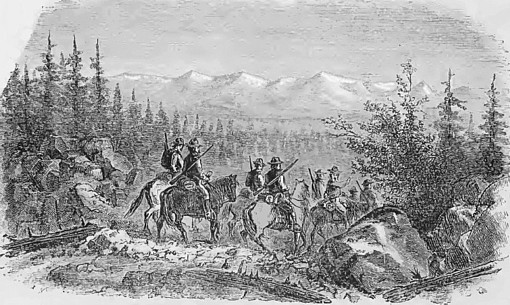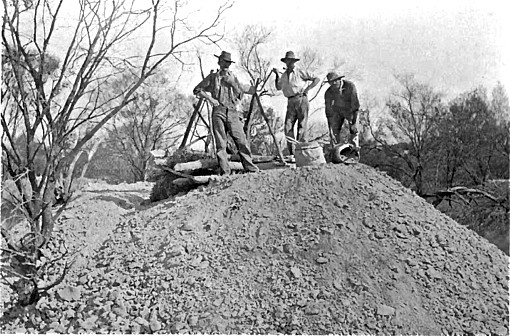The prospector of to-day is often a very different man from his predecessor of a generation ago. The old gold hunter used to sally forth armed with a pick, shovel and pan, and usually a very little grub. In his stead men are now taking the field who have had the benefits of a thorough education, both practical and theoretical, and provided with all the equipment necessary for their work. Some of these men carry an outfit somewhat as follows : An iron mortar holding half a gallon, together with a pestle a rough scale for pulp, a more delicate one showing troy grains and pennyweights, a 40-mesh sieve, a burro furnace and muffle, one cupel mould, a couple of dozen scorifiers, tongs to handle the cupel and scorifiers, two annealing cups, a spirit lamp, a dozen test tubes, a pouring mould, five or six pounds of borax and about as much carbonate of soda, five pounds of bone ash, ditto of granulated lead, a pint of nitric acid, ditto of hydrochloric acid, ditto sulfuric acid, ditto of ammonia, twice as much alcohol and two pounds or so of granulated zinc.
As a blow pipe outfit he will take a blow pipe, spirit lamp, nitrate of cobalt in solution, cyanide of potash, yellow prussiate of potash, red prussiate of potash, a sheet or two of filtering paper and a couple of three inch glass filters. With this outfit he can determine any mineral he may come across. By patience and observation the man who starts out to take1 up prospecting as a road to fortune may easily master the rudiments of his business. It will not take him long to become familiar with the commoner rocks, and the more valuable ores. His own rough tests in the field must be confirmed by competent assayers upon his return to civilization, and in this matter he should be very guarded. The most reliable assays are made either at the different government assay offices or by some of the large metallurgical works whose reputation is world wide. Prospecting is hard work, but the life is healthy and full of excitement, only the explorer should have courage, hope, and good temper, for each and every one will be as necessary in hischosen vocation as his pan and pick.
When alluvial or placer gold has been found it is reasonable to suppose that the vein from which it was derived may also reward diligent search, for it is undoubtedly true that most placer gold has come from quartz veins. This, however, is believed not to be invariably the case, a recent school of mineralogists contending that pure masses of alluvial gold have been formed from the accretion or growth of the gold deposited from certain gold salts. This is in any case probably exceptional, and the prospector who finds gold in gravel should seek in the adjacent country for the quartz lodes from which it came. Important deposits may be expected at or about the line of unconformability where slates, shales, quartzites, sandstones, limestones, schists and other sedimentary deposits are pierced by intrusive masses of igneous rocks.
Veins filling the cracks that once existed between two differing rocks are known as contact veins. Such veins are often very rich. Curiously enough large masses of true igneous rock rarely contain valuable deposits of mineral, but where such intrusive masses cut dikes or walls of porphyry, or diorite, the region is worthy of careful investigation. In an open country the prospector should keep to the hill tops if on the lookout for veins, as the outcrops show more distinctly on the bare ridges, but alluvial deposits are only found in valleys and along the borders of streams. In any case, much of the northern part of this continent can only be prospected by following the streams, on account of the dense growth of forest with which the soil is covered. The true line of strike of a vein can be determined only on a level stretch. The line of strike and the line of dip are always at right angles to one another; the outcrop may follow the strike or it may not.
A pick, shovel, and pan, are absolutely necessary to a prospector's proper equipment. A good pocket lens, cheesecloth screen, and small iron pestle and mortar are often useful. The pan is the most essential part of the outfit, and is always bright from use. The regular gold miner's pan is 13! inches in diameter across the top, 10 inches across the bottom and 2.5 inches deep. The best are made of sheet iron and have a joint around the bottom rim which is of some assistance in retaining the spangles of gold. A more primitive instrument than the pan is the batea. This requires more skill than the pan, and is much in favor with South American miners. It is made of hard wood, 20 inches in diameter, 3 inches deep in the center, inside measurement, and sloping gradually to nothing at the sides. The horn spoon has been handed on from antiquity. It is made from a black ox horn, at least a black one is the best as it shows the gold better; it is eight to ten inches long by three inches wide, cut off obliquely. When gold is suspected in quartz, but there is visible to the naked eye more or less iron, copper, and other base metals, it is well to crush the quartz into coarse fragments. Roast on a shovel or other convenient tool over a hot fire, and finally pulverize in the mortar. If panned it will now reveal much of its gold, while, had these measures not been taken, the sample might have given negative results and been declared valueless.
After pulverizing, the ore should be passed through the cheese cloth screen before panning. If the approximate value of the ore is sought, the sample must be dried and weighed before crushing; and the resulting gold weighed. Thus: About 13 cubic feet of quartz weigh a ton before being disturbed; When broken to medium sized lumps 20 cubic feet may be taken as representing a ton. Although experience teaches the miner to estimate very closely the value of his sample, it is better for the tyro to have a small pair of scales with grain weights. A grain of gold, if tolerably pure, is equal to four cents. Above all things avoid the too common error of panning the pick of the rock, as a false estimate is bound to follow and only too probably eventual loss. A yard of gravel before being dug makes one and a half yards afterwards. A pan of dirt is usually about 20 pounds, although it is not well to fill quite full in actual work.
Many a valuable mine has been found by following up "float" ore. Float is detached fragments of the vein or gangue, and it becomes more and more abundant as the lode is approached until it finally ceases abruptly. This indicates that the vein has been reached or passed, and a trench dug throughout the alluvial soil at right angles to the assumed line of the vein will probably reveal it. The float and mineral of course drift down hill; if the side of the mountain be saddle-shaped the float will spread out like a fan as it washes down, but if concave the force of gravity will concentrate it within a narrow space in the ravine. Float found at the foot of a hill has come, as a rule, from that hill. The nearer the vein the less worn will be the edges of the float and mineral. The gangue or vein-rock in Which the metal is found may be calcite or calc spar, fluor spar, heavy spar or barite, or quartz. Gold is almost always found in this last matrix. The upper parts of most quartz lodes are usually oxidized, that is to say, the atmosphere has acted upon the iron pyrite, freeing the sulfur and staining the quartz yellow, red, or brown, by oxide of iron. This is known as "gossan" or the "iron hat." Such quartz is frequently honeycombed and rotten. Below the water level these veins run to sulfides in which decomposition has not set in, and the gold contained in the quartz is no longer "free milling," i.e. will not give up its gold to mercury without a preliminary treatment. Whenever the explorer comes across a mass of goethite gossan he should sink a trial shaft to the vein, as it is almost certain that below the oxidized sulfides a body of mineral exists likely to encourage mining operations.
Continue on to:
The Basics of
Hard Rock Prospecting, Part 4
Return To:
Gold and Silver Prospecting Basics


